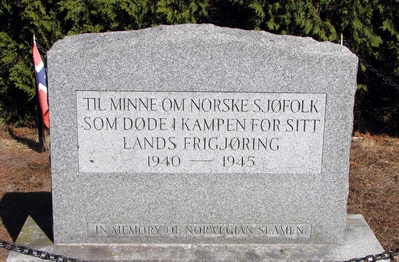 Norwegian Sailors' tombstone in Pine Ridge Cemetery When the Nazis invaded Norway on 9 April 1940, many Norwegian merchant seamen who were at sea at the time came to the US and other allied countries, in the hope of joining the war effort. Given a medical examination in New York City, a number were found to be suffering from tuberculosis, and many of these found their way to Saranac Lake. It is difficult to know how many came, as they were spread among many different cure cottages, but the number may have been as high as five hundred. During the 1940s, sixteen died in Saranac Lake, fifteen men and one woman, a sea captain's daughter; they are buried in a special section of Pine Ridge Cemetery that is maintained yearly at the expense of the Norwegian government.
Norwegian Sailors' tombstone in Pine Ridge Cemetery When the Nazis invaded Norway on 9 April 1940, many Norwegian merchant seamen who were at sea at the time came to the US and other allied countries, in the hope of joining the war effort. Given a medical examination in New York City, a number were found to be suffering from tuberculosis, and many of these found their way to Saranac Lake. It is difficult to know how many came, as they were spread among many different cure cottages, but the number may have been as high as five hundred. During the 1940s, sixteen died in Saranac Lake, fifteen men and one woman, a sea captain's daughter; they are buried in a special section of Pine Ridge Cemetery that is maintained yearly at the expense of the Norwegian government.
Their memorial reads: TIL MINNE OM NORSKE SJØFOLK SOM DØDE I KAMPEN FOR SITT LANDS FRIGJØRING, 1940-45 (In memory of Norwegian seafarers who died fighting for the liberation of their country, 1940-45).
They cured in many places in the village, including the Sageman, Leonard and Walker Cottages on Park Avenue, the Spear Cottage on Riverside Drive, 47 Franklin Avenue and the Robinson Cottage on Franklin Avenue.
See also John Pedersen.
On Monday, November 12, 2018, Natalie Leduc was presented with a Commemorative Medal from the government of Norway for her care of the graves of the Norwegian sailors. The medal is awarded to Norwegian and foreign military personnel and civilians who made great contributions during World War II. As a young girl, Natalie saw some of the soldiers on the streets of Saranac Lake. Knute Grytebust, the last of the sailors who came to Saranac Lake for the cure, died last year. A member of his family in Norway nominated Natalie for the award, which came through the Royal Norwegian Embassy in Washington, D. C. Grytebust's daughter, Kari G. Harrington of North Carolina, and his son Al Grytebust of Malone attended the ceremony. For a full account, see the Adirondack Daily Enterprise, November 13, 2018.
Norwegian Sailors Buried at Pine Ridge Cemetery
| Patient Name | Dates of Birth & Death | Photo |
| Hilda E. Aass | 1913-1943 |
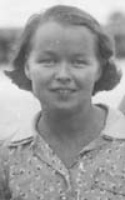 |
| Alfred Abrahamsen | 1920-1945 |
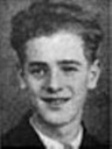 |
| Olaf Berge | 1920-1945 |
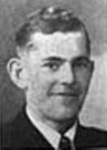 |
| Harry J. Bohler | 1921-1944 |
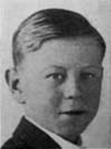 |
| Rasmus Brakstad | 1920-1943 | |
| Haakon Engh | 1914-1945 |
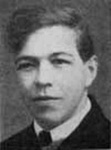 |
| Otto Eriksen | 1906-1942 |
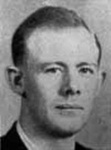 |
| Karl Forsberg | 1911-1944 |
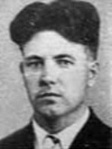 |
| Anker Halvorsen | 1921-1944 |
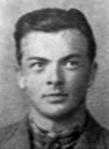 |
| Elias Harkestad | 1910-1945 |
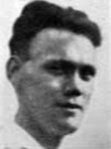 |
| Alfred Larsen | 1913-1988 |
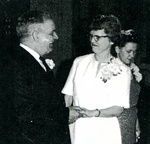 |
| Trygve Magnussen | 1897-1945 |
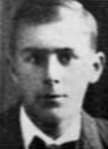 |
| John L. Nyberg | 1917-1944 | |
| Birger Olsen | 1903-1942 |
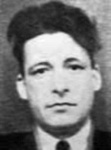 |
| William Paulsen | 1922-1945 |
 |
| Torvald Rongved | 1910-1942 | |
| John Svendsen | 1916-1943 | |
| Knute Grytebust | c. 1921 - 2018 | Not buried in Pine Ridge, but honored here with a stone. |
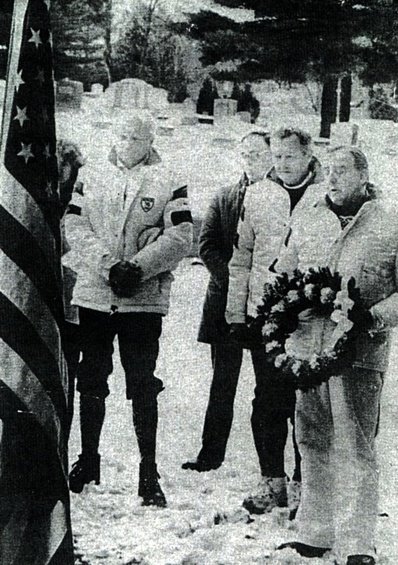 Three Norwegian dignitaries placed wreaths on the grave markers of 16 Norwegian sailors who died in Saranac Lake. From left to right, Oivend Lorentzen, Norwegian Olympic Committee member; Jan Staubo, International Olympic Committee member; and Albert Nordengen, mayor of Oslo, pause at the grave. Undated, unidentified news clipping, c. 1980
Three Norwegian dignitaries placed wreaths on the grave markers of 16 Norwegian sailors who died in Saranac Lake. From left to right, Oivend Lorentzen, Norwegian Olympic Committee member; Jan Staubo, International Olympic Committee member; and Albert Nordengen, mayor of Oslo, pause at the grave. Undated, unidentified news clipping, c. 1980 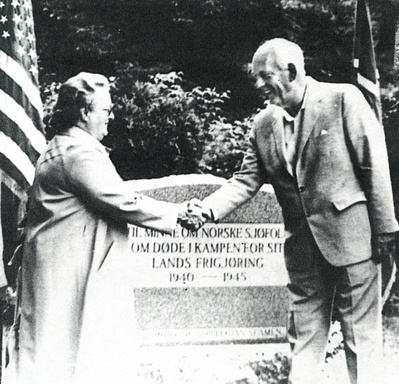 Norwegian Council-General George Thestrup presents a check for $200 to Augusta Pedroni of Saranac Lake for the maintenance of a memorial to Norwegian merchant seamen who died in Saranac Lake during World war II. The monument behind the two reads "In memory of the Norwegian seamen who died in the struggle to free their homeland." Unidentified news clipping dated August 18, 1981.
Norwegian Council-General George Thestrup presents a check for $200 to Augusta Pedroni of Saranac Lake for the maintenance of a memorial to Norwegian merchant seamen who died in Saranac Lake during World war II. The monument behind the two reads "In memory of the Norwegian seamen who died in the struggle to free their homeland." Unidentified news clipping dated August 18, 1981. 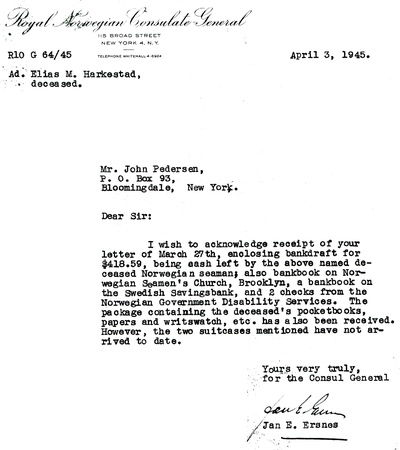 Pine Ridge Cemetery has an extensive collection of correspondence with the Norwegian Consulate about the seamen; this is an example on the occasion of the death of Elias Haarkestad. Courtesy of Natalie Leduc. Adirondack Life, May/June 2007 [Used by permission]
Pine Ridge Cemetery has an extensive collection of correspondence with the Norwegian Consulate about the seamen; this is an example on the occasion of the death of Elias Haarkestad. Courtesy of Natalie Leduc. Adirondack Life, May/June 2007 [Used by permission]
Marooned: when Norwegian sailors found refuge in Saranac Lake
By Mary Thill
Natalie Leduc is the only person at Saranac Lake's Pine Ridge Cemetery early on a drizzly May 17. Except for the fading laugh of a loon flying toward Moody Pond, it's quiet.
Every year on this date, Norway's independence day, Leduc visits the graves of Norwegian sailors buried here. She has placed a little box of pansies on a patch of thyme, violets, wild strawberries and pine needles punctuated by 16 low granite markers and a monument inscribed in Norwegian.
Norway's flag flies over the tidy plot, where a black chain-link fence suspended by anchor-shaped posts separates names like Harkestad and Halvorsen from Coreys, Fortunes and 4,000 other local dead. "The flag is from the Norwegian embassy," Leduc says. The other 364 days of the year, it's kept inside an old vault that once housed bodies in winter, when the ground is too hard to dig. Now the building stores maintenance equipment.
Leduc, a cemetery volunteer, and inmates from Camp Gabriels, a minimum-security state prison seven miles to the north, have in a sense adopted the Norwegian seamen, who died of tuberculosis during World War II. They tend the graves, paint the fence and put out the flag on Syttende Mai. Leduc has grown fond of her helpers, who mow, rake and do other maintenance at Pine Ridge as part of a prison work program. "The guys" take special care of the Norwegians, she notes, who, like them, didn't come here by choice.
Nobody knows for sure how many Norwegian merchant mariners stayed in Saranac Lake because they didn't arrive all at once. But Phil Gallos, author of Cure Cottages of Saranac Lake, guesses the number approached 500. They had been at sea in 1940, when Hitler invaded Norway, so they sailed for New York City in hopes of aiding Germany's foes. Some were rescued from torpedoed ships. Healthy sailors returned to sea to deliver oil to the Allies. But many contracted tuberculosis in close on-board quarters. Those men were sent to Saranac Lake, then a center for TB "curing," a regimen of rest and fresh air.
Some stayed at the Gabriels Sanatorium, which is now the prison that houses the cemetery crew. Others were sent to Stony Wold, a sanatorium near Onchiota, but most lived in smaller cure cottages scattered around Saranac Lake. Leduc was a high-schooler when the Norwegians were in town and remembers them as a lively presence despite their exile and illness. She recalls a story about one sailor who sneaked out of his bed, took a taxi to Lake Placid, entered and won a ski-jumping contest and then vanished from the scene so his doctor wouldn't find out. Another was recruited to help splice a rope into a 2,000-foot loop to tow skiers up the slope at Donnelly's Corners. Locals taught Norwegians how to drive and speak English. In gratitude the recuperating patients gave them Norse lessons and painted a teachers house. Loretto Leonard, an accomplished young pianist, played for sailors staying at her family's cure cottage at 15 (now 28) Park Avenue. The seamen wrote to the Norwegian Consulate in New York City, which sent Leonard two volumes of Edvard Grieg's music and a note, "Please play this to the boys."
With the liberation of Norway in May 1945, the men returned home, with a few exceptions. Jacob Jacobsen and John Pedersen stayed, married local girls and lived to a good age. 1 Another sailor, Alfred Larsen, went back to sea for 20 years but returned in 1964 to propose to the girl who once brought him meals on a tray. ("One day I opened my front door and there he was," says Helen Larsen, now 82. Alfred Larsen died in 1989 and is buried next to his fellow sailors.) Fifteen men, ages 20 to 39, did not survive TB, and a captain's daughter, Hilda E. Aass, age 30, also succumbed. They are the ones who lie in Pine Ridge.
The Norwegian government sends periodic checks for care of their graves. Leduc and her fellow volunteers are on a constant search for funds to keep up the rest of Pine Ridge's six hilly, parklike acres. The first burial was in 1852, when the land was a farm belonging to Saranac Lake's original settlers, the Moody family. Ten-dollar "perpetual care" fees haven't gone far over the years. Catholics, Protestants and Jews are all interred here—it was unusual to have three faiths in a rural burial ground, Leduc says, which is one reason why the cemetery is supported by a nonprofit association, not a house of worship.
Of course Pine Ridge has hundreds of tuberculosis victims. But it hadn't occurred to Leduc until the Camp Gabriels guys, who read epitaphs as they rake, pointed out that a lot of people here died by downing. Four thousand Norwegian sailors would die at sea during World War II. Those here are the ones who found safe harbor.
The Guild News, (published by the Study and Craft Guild) March 30, 1945
Norwegians Inspect Guild Work With Disabled Merchant Sailors
Guild House was visited on March 5 by a distinguished group of officials representing the Social Welfare Committee for Norwegian Seamen in America, agency of the Royal Norwegian Government.
John Pedersen, business agent of the Committee and member of the Guild board of directors, accompanied the delegation which was headed by Fredrik Haslund, executive secretary. Also in the party were Per Thorshaug, director of the Norwegian Disability Service, and Harry Nilsson under whose supervision are the many Norwegian seamen convalescing in the Saranac Lake area.
The officials inspected the classes and workshops of the Guild and expressed satisfaction with the work being done by their men under Guild teachers.
During the winter term thirty-two seamen were enrolled in Guild classes, with twenty-nine studying English, four weaving, three algebra, two mechanical drafting, and one each in arithmetic, bookkeeping, electricity, radio theory, Spanish and typewriting.
On March 3, through arrangements made by the Guild with WNBZ. Mr. Haslund broadcast an address in English and in Norwegian to the seamen billeted here and paid high tribute to the work of the Norwegian merchant marine in the war. He thanked the community and the Guild in particular for the help given patients sent to Saranac Lake by his committee.
This is an undated handwritten report given to Natalie Leduc sometime in the 1980s. It was likely written by former patient and medical librarian Nadia Slack, at the request of Janet Decker of the Adirondack Collection, Saranac Lake Free Library, where the original is kept.
During the World War II Norwegian seamen of the Merchant Marine at sea in conjunction with the underground rendered a tremendous contribution by continuing the fight delivering in Norwegian tankers, half of the oil needed by the Allies to continue the war.
In the course of this endeavor hundreds of the seamen contracted tuberculosis. Some became ill on ships, others were torpedoed in the Atlantic, not only once but twice and more. There was another incident of an oil tanker colliding with another in New York harbor.
All Norwegian seamen were brought to New York, and those suffering from tuberculosis were transferred to Saranac Lake – a health center at that time. The Norwegian government made all the arrangements for their treatments.
A large number were accommodated in Gabriels Sanatorium under the care of Dr. John Hayes, at Stony Wold under the care of Dr. Wayne Henning, and in the private cottages through the village under the care of Drs. Daniel Brumfiel, Henry Leetch, Woods Price and other specialists.
Several seamen were at the Leonard Cottage, 15 Park Avenue. Mrs Leonard's daughter, Miss Loretto Leonard, an accomplished pianist, often played for them, particularly they loved the Solveig's song by Edvard Grieg. Some of the seamen wrote to the Norwegian Consulate in New York about the joy Miss Loretto Leonard's playing brought them, and the Consulate sent her two large volumes of Griegs's music with a note saying "Please play this to the boys."
At Christmas time and at other holidays the seamen were richly remembered with gifts and food from their homeland. Sonya Henie contributed generously to this.
Mrs. Edward (Millie) Levy gave the seamen English lessons. Some at the bedside, some in small groups at the sanatoriums and cottages. Later a group of seamen who were on their way to recovery and wanted to reciprocate her kindness offered to paint her house. She accepted their offer, and was deeply touched by their kind deed.
Three Norwegians, Mr. John Pedersen, Mr. Alfred Larsen and Mr. Jacob Jacobsen met and married their future wives in Saranac Lake, and all are still here.
Mr. John Pederson, besides curing, was in a capacity to oversee the needs & wishes of the sick men, and he kept in close touch with them, [acting as a liaison with the Norwegian Consulate].
See also: Hjalmar Berentsen
There is a Report of a Case of Tuberculosis card in the Adirondack Collection, Saranac Lake Free Library, for Mr. Carl Lumholz (sic), the renowned Norwegian anthropologist and explorer. His card was handwritten on 12/16/1921.
A complete list of known Norwegian Sailors
Click on names that are underlined for more information about that individual. As of 6/23/2015 there were 97 on this list.
| Name | Cure Facility | Ship;Occupation | Date of Birth | Date of Death | Notes |
| Bjarne Aanesen | Fortune Cottage | Motorman | c. 1915 | card M#1, 1/12/44 | |
| Lars Aanestad | Sageman Cottage | Seaman | c. 1917 | card M#2, 10/29/43 | |
| Karl Aasheim [or Aarsheim] | Stony Wold Sanatorium | 6/17/1906 | no card | ||
| Hilda E. Aass | Ada | October 11, 1913 | 1943 | She was the daughter of sea Captain Hans Fredrik Melanchton Aass. She is buried in Pine Ridge. No card. | |
| Alfred Abrahamsen | Possibly the Lake Traverse | 4/9/1920 | 9/13/1945 | buried in Pine Ridge; no card | |
| Magnus Alstad | Sageman Cottage | Signalman | c. 1922 | card M#2A, 10/29/43 | |
| Henry Andersen | Stony Wold Sanatorium | M/S Lise | 6/18/1918 | no card | |
| Henry Anton Andersen | Fortune Cottage | Engr. | c. 1904 | card M#3, 1/12/44 | |
| Ole Andersen | Sageman Cottage | Navy | c. 1889 | card M#4, 7/13/43 | |
| Robert Andreassen | Sageman Cottage | Sailor/Seaman | 7/4/1914 | 2 cards, M#5 & 6, 1/27/43 & 4/24/44 | |
| Sverre Andreassen | Stony Wold Sanatorium | M/S Elizabeth Bakke | 4/9/1913 | no card | |
| Johann Martin Anstensen | Stony Wold Sanatorium | S/S Evanger | no card | ||
| Hjalmar S. Berentsen | Leonard Cottage | S/S Bris | 3/8/1903 | no card | |
| Olav Berge | Fortune Cottage | Tancred; Ship motorman | c. 1920 | 1945 | card M#7, 7/13/43; buried in Pine Ridge |
| Alf Bergthun | Stony Wold Sanatorium | M/S Brimanger | no card | ||
| Birger Berntsen | Stony Wold Sanatorium/Sageman Cottage | 1/16/1912 | no card | ||
| Modolf Berthelsen | Sageman Cottage | M/T Daghild | 3/30/1914 | no card | |
| Bizarne Birkeland | Sageman Cottage | Chief mate | c. 1898 | card M#7A, 6/26/43 | |
| Harry J. Bohler | Sageman Cottage | M/T Bianca | 1/25/1922 [sic:1921?] | 1944 | no card; buried in Pine Ridge |
| Rasmus Brakstad | Sageman Cottage | S/S Gansfjord | 1920 | 1943 | no card; buried in Pine Ridge |
| Karl Brattegjerde | Stony Wold Sanatorium/Sageman Cottage | 11/19/1915 | no card | ||
| Trygve Bredetrup | McCabe Cottage | M/S Solstad | 2/1/1905 | no card | |
| Hjalmar Brennstrøm | McCabe Cottage | S/S Askild | 7/10/1914 | no card | |
| Carl Aage Carlsen | Gabriels Sanatorium; Fortune Cottage | Seaman | c. 1921 | card M#8, 3/8/44 | |
| Elling Carlsen | McCabe Cottage | Anna | 12/26/1901 | no card | |
| Gustav Davidsen | Stony Wold Sanatorium | 10/23/1909 | no card | ||
| Arnstein Draagen | Spear Cottage | Seaman | c. 1923 | card M#9, 12/13/43 | |
| Peder Drageland | Stony Wold Sanatorium | M/S Leif | 8/13/1918 | no card | |
| Konrad Drønen | Leonard Cottage | M/T Koll | no card | ||
| Ingebregt Eik | Sageman Cottage | sailor | c. 1914 | card M#9A, 7/13/1943 | |
| Haakon Engh | 1914 | 1945 | no card; buried in Pine Ridge | ||
| Otto Eriksen | 1906 | 1942 | no card; buried in Pine Ridge | ||
| Eivind Eversen | Spear Cottage | Machinist | c. 1906 | card M#9B, 11/8/1943, in the name of Eiwind Eversen; his last name may be Evesen. Eivind (NLN) wrote a Christmas card to the Spears. | |
| Waldemar Fahlstrøm | Leonard Cottage | M/S John Bakke | 3/11/1923 | no card | |
| Fridtjof Folkestad | Sageman Cottage | Cook | 4/10/1921 | card M#10, 1/27/43 | |
| Karl Eugene Forsberg | Sageman Cottage | Seaman | c. 1911 | 1944 | card M#11, 2/25/43; buried in Pine Ridge |
| Alf B. Fredriksen | McCabe Cottage | Seaman | 7/27/1903 | card M#12, 2/25/43 | |
| Bjarne Furevik | Spear Cottage | sailor | c. 1917 | card M#12A, 5/22/44, in the name of Buarne Furerik | |
| Torleif Gjersvik | Stony Wold Sanatorium; 29 Church Street | M/S California Express/Photographer | 11/7/1920 | card M#13, 10/12/46 | |
| Knute Grytebust | c. 1921 | 2018 | no card, buried in Malone | ||
| Marius Hafstad | McCabe Cottage | S/S Askild | 2/17/1887 | no card | |
| Anker Halvorsen | Spear Cottage | Seaman | c. 1921 | 1944 | card M#14, 8/24/43; buried in Pine Ridge |
| Sivert Handegaard | Sageman Cottage; Fortune Cottage | M/T Koll/Sailor | 8/25/1907 | card M#15, 5/22/44 | |
| Eivind Hansen | Sageman Cottage | M/T Havprins | 10/4/1915 | no card | |
| Haakon Hansen | Stony Wold Sanatorium | M/T Kallfonn | 3/12/1913 | no card | |
| Magnus Hansen | Stony Wold Sanatorium | M/T Stigstad | 4/17/1917 | no card | |
| Terje Kristian Hansen | Sageman Cottage | M/S Buenos Aires;Seaman | 10/21/1909 | card M#16, 3/11/44 | |
| Elias Harkestad | McCabe Cottage | S/S Lista | 12/10/1910 | 1945 | no card; buried in Pine Ridge |
| Iver Hersoug | Stony Wold Sanatorium | M/S Toronto | 6/21/1907 | no card | |
| Ingemann Howland | Stony Wold Sanatorium | 9/25/1921 | no card | ||
| Wendel Jacobsan | Leonard Cottage | M/T Kolbjorg | probably same person as Jacob Jacobsen, below | ||
| Jacob Jacobsen | Smithwick Cottage | Sea Captain | 9/18/1909 | 3/9/1986 | card M#17, 12/13/43; settled in Saranac Lake |
| Marcus Stole Jakobsen [or Markus] | Stony Wold Sanatorium | M/S Fenmor | 11/14/1914 | no card | |
| Einar M. Jensen | Sageman Cottage | Sailor | c. 1913 | card M#18, 6/5/43 | |
| Miss Vivian Jensen | Stony Wold Sanatorium | M/S Ogna | 2/19/1911 | no card | |
| William Russell Karlsen | Sageman Cottage | Fireman | 4/26/1923 | card M#19 for William Russell Karlsen, 2/11/43 | |
| Einar Klaudiussen | Sageman Cottage | Second mate | 12/28/1914 | card M#20, 2/11/43 | |
| Fritz Kristiansen | Stony Wold Sanatorium | M/T Charles Racine | 5/4/1907 | no card | |
| Petter Kristensen | Sageman Cottage | Fireman | c. 1917 | card M#21, 10/29/43 | |
| Osvald Kristoffersen | Stony Wold Sanatorium | S/S Carrier | 1/9/1916 | no card | |
| Kaare Kvikne | Spear Cottage | Sailor | c. 1893 | card M#22, 12/12/43; returned home 12/1945, wrote postcards to Spears 12/45 to 3/46 | |
| Lars Kyrkjebo | Spear Cottage | Sailor | c. 1917 | card M#23, 11/8/43 | |
| Knut Langemyr | McCabe Cottage | Britanina ? | no card | ||
| Alfred Rasin Larsen | Sageman Cottage | Motorman | 11/15/1913 | 1988 | card M#24, 2/13/43; buried in Pine Ridge |
| Arve Larsen | Stony Wold Sanatorium/Sageman Cottage | 10/16/1908 | no card | ||
| Christian Larsen | Stony Wold Sanatorium | S/T Mirlo | 11/12/1910 | no card | |
| Einar Larsen | Sageman Cottage | Painter | c. 1906 | card M#25, 10/7/43 | |
| Jakob Lilleheim | Stony Wold Sanatorium | M/T Hamlet | 4/24/1922 | no card | |
| Olaf Lindtvedt | McCabe Cottage | M/T Sandar | no card | ||
| Kaare Ole Lund | 71 Bloomingdale Avenue | Norwegian Merchant Fleet | c. 1916 | card dated 2/1/1944 | |
| Bernhard Lyngstad | McCabe Cottage | Seaman | c. 1914 | card found, 2/25/43 | |
| Trygve Magnussen | 1897 | 1945 | no card; buried in Pine Ridge | ||
| Rolf Mantzoni | 35 Franklin Avenue | Norwegian Merchant Fleet; A. B. (?) | c. 1919 | card dated 6/24/1944 | |
| Kjell Markussen | Rio Branco | 6/9/1904 | no card | ||
| Nils Milvartsen | Spear Cottage | Seaman | c. 1917 |
card M#26A, 11/8/43, age 26 Tgolleng, Norway |
|
| Sigurd T. Nordberg | Leonard Cottage; Sageman Cottage | S/S Balla/sailor | 9/1/1914 | card M#27, 5/22/44 | |
| John L. Nyberg | Fortune Cottage | Fireman | 10/7/1917 | 10/15/1944 | card M#28, 12/15/43; buried in Pine Ridge |
| Alive Olsen | Sageman Cottage | Oiler—boat | c. 1921 | card M#29, 10/4/43 | |
| Axel Olsen | Stony Wold Sanatorium/Sageman Cottage | 9/11/1904 | no card | ||
| Birger Olsen | 1903 | 1942 | no card; buried in Pine Ridge | ||
| Johan A. Olsen | Stony Wold Sanatorium | S/S Marpesia | 7/11/1895 | Captain; no card | |
| Oscar George Olsen | Stony Wold Sanatorium | Kristian Krogh | no card | ||
| Trygve Olsen | Sageman Cottage | Sailor | c. 1902 |
card M#30, 11/6/43, age 41 Tunsberg, Norway |
|
| William Paulsen | McCabe Cottage | Motorman | 1922 | 1945 | card M#31, 12/13/43; buried in Pine Ridge |
| Egil Pedersen | Stony Wold Sanatorium | 6/6/1919 | no card | ||
| Louis Mangaard Pedersen | Stony Wold Sanatorium | M/T Solstad | 9/14/1904 | no card | |
| Hendrick Petersen | Spear Cottage | Seaman | 1903 | card M#32, 5/1/44 | |
| Odin Rasmussen | Stony Wold Sanatorium | S/S Eastern Star | 8/16/1908 | no card | |
| Thorvald Rognved | McCabe Cottage | M/S Ivaran | 1910 | 1942 | Torvald Rongved; no card; buried in Pine Ridge |
| Kristian Skaar | Leonard Cottage | M/S Oregon Express | no card | ||
| Kolbjorn Skaaren | Sageman Cottage | M/T Vanja | 12/30/1906 | no card | |
| Bjarne Sorvaag | Sageman Cottage | M/T Sandar | 3/26/1915 | no card | |
| Harrald Spernes | Stony Wold Sanatorium | SS Elizabeth Bakke;Seaman | 1920 | card M#33, 2/26/43 for Harold Christian Spernes | |
|
[or Jostel Stavane] |
Stony Wold Sanatorium | M/T Stigstad | 10/8/1920 | no card | |
| John Otto Svendsen | Sageman Cottage | 1916 | 1943 | no card; buried in Pine Ridge | |
| Waldemar Tallaksen | Stony Wold Sanatorium | Bergensfjord | 10/27/1902 | no card | |
| Trygve Thoresen/Thorsen | Stony Wold Sanatorium/Sageman Cottage | 11/30/1920 | no card | ||
| Toralf Toresen | Stony Wold Sanatorium/Sageman Cottage | 1/15/1900 | no card | ||
|
[or Ejoakam] |
Stony Wold Sanatorium | M/S Primero | 8/8/1898 | no card |
Adirondack Daily Enterprise, May 29, 2000
Pine Ridge Cemetery reveals chapter of Saranac Lake's wartime history
Special to the Enterprise
SARANAC LAKE — Near the vault in Pine Ridge Cemetery is a plot bordered by a fence of distinctive nautical design. The iron posts are anchor-shaped, and each one is joined to the next by a chain.
Within this fence are 17 head-stones, arrayed around a large marker. On the marker is an inscription few locals can read, for it's in Norwegian. A partial translation underneath reads: "In memory of the Norwegian seamen."
How did this plot come to be?
It's a tale that begins on April 9, 1940, with the German invasion of Norway. Norway, a seafaring nation, had a fleet of 4.8 million tons, only 800,000 tons of which was captured by the Germans. The rest joined forces with the Allies for the duration of the war.
When a Norwegian ship arrived in New York, its crew was immediately given a health screening. Those who passed were returned to sea duty. Those who failed were sent for treatment and convalescence. As might be expected in the 1940s, many were diagnosed with tuberculosis, and many of them were sent to America's first TB cure center Saranac Lake. All of this explains how Norwegian sailors came to Saranac Lake. There is no official tally available, but for the WWII years, it is believed that hundreds of Norwegians took the cure here. According to Phil Gallos' book, Cure Cottages of Saranac Lake, "...the number may have approached 500."
Exact numbers aside, they were certainly a town presence. Natalie Leduc recalled, "During the war years, I saw the Norwegian sailors around town, of course."
Then, laughing, she continued, "The funny thing is I knew they were Norwegian sailors, but I don't know how I knew. Maybe my mother told me originally."
The Norwegian sailors were housed in various locations. Out of town, they were in Stonywold (later the White Fathers) on Lake Kushaqua, and at the Gabriels sanitarium. In town they were in the Leonard's cure cottage on Park Avenue, Ethel Walker's cure cottage on Riverside Drive, McCabe's on Franklin Avenue, and the Sageman Cottage on Park Avenue.
As good as the treatment the Norwegian sailors received (and at the time it was as good as the best in the world), a TB cure in those pre-antibiotic days was hardly a sure thing. Thus, the Norwegian burial plot in Pine Ridge.
Fully translated, the inscription on the Norwegian main marker reads: "In memory of the Norwegian seamen who died in the struggle to free their homeland." Overall, during WWII, 3,000 Norwegians died at sea. But it's not known if those buried in Pine Ridge are counted in that number, due to their unusual status as casualties.
Certainly, two of them are clearly exempt from the 3,000. One was Hilda Aass, who wasn't a seaman at all. If any label for her is appropriate, it's "seawornan." She wasn't in the merchant marine, but was a captain's daughter who had come to the United States on her father's ship (though under what circumstances, it is not clear). The other exception was a man named Alfred R. Larsen. He was a merchant mariner and had been one since 1931, but his status among his comrades in Pine Ridge is as unique as Hilda Aass'. For of the 17 Norwegians buried there, 16 died during the war years, 1940-1945. Mr. Larsen, however, lived until 1988. He spent the last 24 years of his life in Saranac Lake, after marrying a local woman and making Saranac Lake his home.
It's a long story that begins on the day the Germans invaded Norway. Alfred Larsen left his home town and home port, Bergen, arid sailed into the North Sea aboard the tanker Egba. Later, he was on other ships, sailing to such distant ports as Liverpool, England; Monrovia, Liberia; and Jamaica, West Indies. His duty was hardly all exotic, however, since in the course of his wartime service, he was on three ships that were sunk by German U-boats.
Then on Feb. 12, 1943, in New York City, Larsen was diagnosed with TB. He was sent to Saranac Lake, the doctor in New York telling him it was a good place to be. Years later, Larsen said of his reaction at the time, "I didn't even know what a Saranac Lake was."
He soon found out, as he settled in the Sageman Cottage, along with other Norwegian sailors. This may have been a comfort to him, since at the time he spoke no English. But he changed that by taking English courses at the Guild from Mrs. Levy, and quickly became fluent.
With his new fluency, he made a new friend. She was Helen Bell, a local high school girl who was a "tray girl" and all-around house-keeper at the Sageman Cottage.
When the war ended in 1945, Larsen was cured of TB, and so returned to Norway, where he later rejoined the merchant marine. He stayed in the merchant marine for the next 19 years, sailing everywhere, according to him, except Greenland. But no matter how far away from Saranac Lake he was, he never lost touch with it, for he and Helen Bell remained steadfast — if not world-class pen pals: Helen estimates she wrote him a letter a week the entire time. While she's not sure if he wrote back as often, she said he answered most of the letters.
"And he always sent a card from every port," she said.
In the summer of 1964, Larsen retired from the merchant marine after 31 years, and he wrote Helen, asking her to come to Norway. She wrote back, telling him to come to Saranac Lake. She heard nothing more from him.
Then one day (a couple of months later) there was a knock on her door. When she opened it, there stood Alfred R. Larsen. They never again wrote each other a letter, nor did they have to, since after that day they were never apart.
Wedding Bell
About a month later, he asked her to marry him, and she accepted. After a 20-year, long-distance courtship, they were in no hurry to marry, but Larsen, being an old-fashioned gentleman, first had a formality to take care of: In December 1964, he asked Helen's mother for permission to marry her daughter.
He hadn't told Helen he was going to ask her mother's permission, but that didn't matter to her.
"She would've given permission anyway," Helen said. "She liked him."
Then she added, "Everyone liked him."
On Dec. 26,1964, Helen and Alfred were married in the First United Methodist Church in Saranac Lake. Aside from their wedding, there was something else memorable about the day: There was no snow on the ground.
"I couldn't believe it," said Helen. "It was a green Christmas — back when we used to get real winters."
That summer, Alfred's visa expired, so he and Helen decided to go back to Norway to wait, for his green card to get processed. They both sailed back on a Norwegian tanker.
As Helen put it "I was part of the crew, or the baggage — what-ever you want to say."
The Larsens settled atop Lake Street Hill, eventually living in her family home on 4 Jenkins St. Alfred worked for Will Rogers Hospital and the Saranac Lake General Hospital; Helen worked for Woolworth's and Saranac Lake News.
Aside from a two-week visit Helen and Alfred made in the 1960s, Larsen never returned to Norway. But he continued to pay homage to his homeland and his fellow sailors. Every May 17, Constitution Day (which is the Norwegian equivalent of a combined Independence Day and Memorial Day.) he made a special visit to the Pine Ridge plot.
After Alfred's death, Helen had her own Constitution Day ritual: She put an announcement in the Adirondack Daily Enterprise and on WNBZ-AM, wishing all Norwegians a happy Independence Day. After several years, she stopped, since she had never received any replies.
"I guess: there weren't any Norwegians around anymore," she said.
They never owned a car, and Alfred rode a bike to work, he also loved to walk, and he would carry groceries back from the downtown stores — sometimes twice a day.
"It's what kept him healthy," Helen said, "walking up and down Lake Street Hill."
In 1988, after 24 years of marriage and 45 years of friendship, Alfred Larsen passed away. Helen is hale and healthy and living in the Dechantal Apartments.
The Last Word
None of the thousands of letters the Larsens wrote each other survived a half century's house-cleaning. But something Alfred wrote on a questionnaire for Historic Saranac Lake's 1987 reunion of former TB patients did survive, and it speaks for itself.
The question asked: "Has TB changed your philosophy of life, and how?"
Alfred's answer was: "Yes. I came here and met my wife, and we are enjoying every minute of it."
The following three items from diverse sources refer to Norwegian sailors at Stony Wold:
Adirondack Daily Enterprise, March 2, 2013
From Howard Riley's column: Part 2: Stony Wold Sanatorium, quoting from the memoir of Carl F. Jacobs (1933-2012), whose father Pearly Jacobs worked at Stony Wold.
"During WWII, we [at Stony Wold] had a lot of Norwegian sailors that were also curing. They were young and were not used to lying around and had some novel ways of passing the time."
Excerpt from an undated report written for the Sisters of Mercy by Sr. Agnes Martin:
Following the Great Depression, Sanatorium Gabriels was experiencing not only financial problems, but also a lack of patients. However, God again showed his interest in the Sisters' work. In the early 1940's, during World War II, a Norwegian ship was torpedoed and sunk. Many men lost their lives, but a number of sailors were rescued. Through their exposure to the sea and elements, it was found that many of these rescued men had developed TB. For some reason, the Norwegian Government could not bring them back to Norway, so made arrangements for their care at Stony Wold Sanatorium, a few miles from Gabriels. These patients, perhaps because of loneliness and lack of communication due to the language barrier, became a problem to Stony Wold due to their drinking and carousing. The Norwegian Officials were at a loss what to do about it, until it was suggested to them to ask the Sisters at Gabriels to take care of them. The Sisters immediately accepted. It was not long before the Sister Nurse in charge had them well under control, and these men had the greatest respect and love for her, as well as all the Sisters. They remained at Gabriels until the end of the war when they returned to their own country. The income derived from their care kept Gabriels going.
Kaare Kvikne was a Norwegian sailor who cured for TB at the Spear Cottage, and apparently also at Stony Wold. He returned home in December of 1945, and sent several postcards back to the Spears between December 1945 and March 1946. One mentions Stony Wold: "February 24 - [19]46: Dear Emma, I couldn't get a chance to come to the village and say good buoy [sic] to you They were to strict at Stony Wold I have travelled around this country visiting relations for a month. Now I am training on skis every day and I enjoy it very much. Hope you are well and in good health. Best regards from KAARE KVIKNE"
Summary Report from the Social Welfare Committee's "Gift Fund Committee at its meeting in New York, December 2nd, 1942.
1. The Social Welfare Committee's "Gift Fund Committee" at its meeting yesterday decided to request our doctors to confer with Dr. Henning about the possibilities of having sister Helga be given more time so she may be able to work more closely with the Norwegian patients at Stony Wold and in Saranac Lake. To make it possible for her to do so, the committee decided to pay all her expenses for taxi or other means of transportation to Saranac Lake for visits to the patients in the 4 cottages there.
See Stony Wold page for full text of this report. Note the early date: most information we have on the Norwegian seamen who were patients is from 1943-45. In those years at least six private cottages in the village cared for Norwegians.
External links:
- A Norwegian site (in English) that gives brief biographies and photos of each of the sailors
- http://www.norway.org/News_and_events/top-stories/Siri-Lawson-Founder-of-warsailorscom-Awarded-Order-of-Merit/
Note: The image below has been mistakenly identified over the years as a photo of Norwegian sailors. Natalie Leduc says it was from a photo album belonging to Ethel Walker, who ran a cure cottage that took care of some of the Norwegian sailors. The photo appears on page 76 of the book Cure Cottages of Saranac Lake, and the caption implies that the photo is of Norwegian sailors. However, a note in the Historic Saranac Lake files says that in 1990, Christian R. Sporck spoke with Barbara Parnass about the photo. He identified his father, Christian Sporck on the far right in the photo, and said that he believed the other men were patients from Reception Hospital.
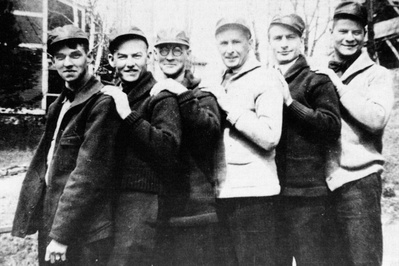 These men were once thought to be Norwegian Sailors in Saranac Lake. From an album of Ethel Walker's, courtesy of Natalie Leduc.
These men were once thought to be Norwegian Sailors in Saranac Lake. From an album of Ethel Walker's, courtesy of Natalie Leduc.
The Guild News, September 1942
"Cottage Calls"
This month the Cottage Caller stopped in at the Sageman cottage, 32 Park Avenue, to chat with a group of Norwegian merchant seamen. A more gallant gathering was never housed under one roof. Our hats are off to them.
On the first floor we found Kolbjorn Skaaren who shipped with the merchant marine for several years. He knows the West Indies well, for he made regular trips between there and England carrying oil. In 1938 he began carrying oil from Mexico to (of all places) Germany. "Had I known about this war," he said, "I would have pumped all the oil into the ocean before I would have let Germany get it." Mr. Skaaren has a wife and a small boy in Norway. The war cannot end too soon for him as he has never seen his son.
Out on the porch we found Modolf Berghelsen and Terje Hansen. Mr. Berghelson hasn't been home in four years, but Saranac Lake is some comfort because it is very like Norway. He never tires of looking at the mountains. Mr. Hansen spends the major portion of his time reading and listening to the news broadcasts. When we asked him about this man, Quisling, he summed him up in four words, "Just a big mess."
On the second floor were Peter Drageland, Bjorn Sarvaag, and John Swenson. On May 2, 1942, Mr. Sarvaag was torpedoed off the West Indies. The German torpedo struck their boat amidships and set afire their cargo of oil. Several of the men were badly burned, and the German officer generously gave them salve and dressing for their wounds. Seventeen hours later they were picked up by an American vessel.
John Swenson is only a boy, but sailing is an old story to him. He likes dancing, movies and, most of all, girls. "Any special girl?" we asked. "No," said John, "just play the field. It's better that way, don't you think?" We declined to answer.
Captain Kjell Mirkussen of Sandefjord, Norway, arrived last Friday. He has been sailing since 1919 and has stopped at Japan many times. He had quite a bit to say on the subject of the Japanese.
"Even in 1938 when I first went there they hated all Americans," he said. "Never, never did I trust them. They do not say what they mean, nor do what they say. You never know what they are up to." We agreed.
On May 14th, Capt. Mirkussen was somewhere in the Atlantic when he was torpedoed by a German submarine. The men set out in life boats and five hours later were picked up by a Yugoslavian ship. At 2:30 A.M. on the morning of May 15th, that ship was sunk by a German U-boat. Again the men set out in life boats. It was seven hundred miles to the coast of Venezuela but they finally reached shore. There the British consulate took over, and now, six weeks later, Captain Mirkussen is resting in Saranac Lake.
Sievert (Squeaky) Handegaard is well acquainted with America. For two years he sailed on the Great Lakes from Chicago to Buffalo. That life was too quiet, so "Squeaky" went into the Norwegian merchant marine. He got all the excitement he was looking for. Last May his boat was bombed by Germans from the air. "They aren't very good shots," he said. "Some of those bombs missed the boat by a couple of feet. Got pretty wet from the spray though."
Eivind Hansen was our last call. He has been here a month and commented again on how much Saranac resembled Norway. "Norway is home," he said, "and I am anxious to go back. But next to Norway, America is the best place in the world."
The Guild News, October, 1942, page 5
"Norwegians are Coming!
Last month in the Cottage Calls column The Guild News told the story of the fine Norwegian sailors who are curing at the Sageman cottage. There is a sequel to that story. The reporter who interviewed these men realized the tremendous handicap they had in not being able to speak the English language. She mentioned to one or two of them that a course in Americanization English was offered by the Guild. "Yah?" they said and that was the end of the matter for a time.
A week later came a request for a teacher to go and see how many would enroll. The result was twelve registrations for either class or private instruction. The grapevine carried the word down to 15 Park Avenue. In came three more requests, and following them, three more registrations. The end of the story cannot be written yet. The Guild has learned that there are other Norwegians at 35 Franklin who are eager to learn the American tongue.
And what have the teachers to say about their students? Only that they are among the best and most sincere pupils that they have, and that it is a joy and a privilege to teach them.
The Guild News, October 1945
"Home Town Jottings"
With the exception of a few, all the Norwegian Merchant Marine seamen who were sent to Saranac lake to recuperate from tuberculosis, have started back to their native land. The majority were at Stony Wold and Gabriels, and some had been here for two years.
Footnotes
1. Actually, Pedersen came to Saranac Lake in 1924; he married a Norwegian woman. He worked as a liaison between the Norwegian government and the sailors. He became an American citizen and lived in Bloomingdale until his death.



